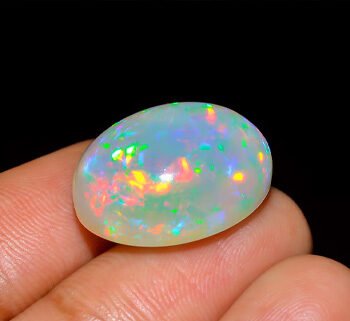Don’t we all love gemstones for their luster? But apart from their stunning radiance, most people also feel an unexplainable pull towards them. There’s a saying – no gemstone ever comes into your life without a purpose, and it comes exactly when you need it, neither early, nor late. Imagine that feeling we get when we browse stunning jewelry pieces, and our eyes also shimmer the same way gemstones do. That’s not just a coincidence, but your soul telling you what it likes at first glance.
However, today most of us do love the convenience of online shopping, but it can also be challenging for first-time buyers. From comparing the opal stone price to checking authenticity, there are many factors that one needs to consider to get the real deal in terms of energy, authenticity, and money. In this blog, we’ll explore the best tips for every buyer out there!
Know What You Want: Purpose, Look & Energy
The first and foremost thing to consider is the “why” behind your purchase. Ask yourself:
- Am I buying a gemstone for its healing power or astrological value?
- Am I looking for a beautiful gem for a custom jewelry?
Once you have your purpose figured out, it becomes easier to choose gemstones that are right for you.
For instance, if you’re seeking inner peace, then amethyst is a good option. On the other hand, if you want to invite positivity into your life, then look no further than a citrine or green aventurine. If love and emotional balance are your goals, then rose quartz can be your go-to.
Knowing what you want helps you narrow down choices and also gives you confidence when exploring gemstones and crystals for sale.
Not to forget, understanding your purpose also helps you assess how much you’re willing to invest. That’s because the prices also vary depending on the different types of stones. For example, a high-quality Ethiopian opal might cost more than a lab-created one, but it’s worth every penny if authenticity matters to you.
Shop From Trusted Websites or Sellers
If you’re buying gemstones for their energetic value, then go for reputable platforms that:
- Clearly mention whether the gemstone is natural, treated, or synthetic
- Offer images of gemstones taken under clear lighting conditions and from different angles
- Offer gem certification from recognized labs.
- Have customer reviews
A legit seller will never shy away from questions about origin, authenticity, or treatments.
Bonus points if they also offer expert consultations, as it’s helpful for first-time buyers, who usually don’t know which gemstone cuts or types are ideal for which purpose. For example, semi-precious gemstone cabochons are best suited for jewelry. On the contrary, raw or free foam stones are ideal for healing and home décor.
Understand the Types of Gemstones Being Sold
There’s a big difference between a raw gemstone, a cut-and-polished one, and something that’s just dyed glass.
Some platforms specialize in cabochons in stones like larimar, labradorite, moonstone, and chrysoprase. And trust us, when you see a well-cut labradorite cabochon in natural light, you’ll know why cabochons have a loyal fanbase.
But again, it all comes down to what you’re looking for and finding something that fits within your budget. Gladly, cabochons serve multiple purposes. You can meditate with them, customize them into a jewelry piece, place them on your desk, or simply carry one in your pocket. Since they’ve got a smooth finish, they don’t scratch your skin or any surface they come in contact with, and that’s what we really love about cabochons.
Just make sure you’re clear about the treatment. “Stabilized”, “heat-treated”, or “dyed” aren’t necessarily bad words, but they should always be disclosed when you buy online gemstone. Generally, leading sellers always disclose all the crucial information about gemstones like origin, authenticity, cuts, treatments (if any), and special care instructions.
Ask for Certification for Safe Gemstone Shopping
Whether you’re spending $5 or $50, you deserve proof that your gemstone is what the seller claims it to be.
A certificate from a gemological lab (like IGI, GIA, or GII) ensures that the stone has been tested for authenticity and is not synthetic, lab-grown, or overly treated. While not all low-cost stones will come with this by default, most genuine sellers will offer certification as an optional add-on.
Beware of “Too Good to Be True” Pricing
High-quality gemstones come at a cost. If a store is offering rare stones like natural ruby, emerald, or high-flash opals for shockingly low prices, it’s time to raise your eyebrows as a first-time gemstone buyer.
Often, these are either synthetic stones passed off as natural or highly treated ones that look good initially but lose their charm over time.
Here’s a quick cheat sheet:
- High-quality moonstone should show a blue sheen.
- Labradorite should have visible flashes (not just a plain grey stone).
- Citrine should have warm yellow tones, not overly bright like lemon candy (which usually indicates heat-treated amethyst).
Read the Fine Print
Before you hit “buy now,” take a quick detour to the policies section.
- Do they have a return policy?
- What happens if the stone arrives damaged?
- Do they have a gemstone buying guide section on their website? (It helps first-time buyers a lot, trust us)
- Will they exchange a piece if you’re unsatisfied with its energy or appearance?
The Final Words – Buy Smaller First, Then Upgrade
If you’re a first-time buyer, then we’d suggest starting with small purchases first and then going for higher-end gems. Once you start buying, you’ll know what to look for. Besides that, your intuition also guides you. So, most importantly, listen to your inner voice and choose stones that your soul also chooses to be with.
